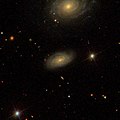| NGC 2 | |
|---|---|
 NGC 2 by the DESI Legacy Surveys | |
| Observation data (J2000 epoch) | |
| Constellation | Pegasus |
| Right ascension | 00h 07m 17.1s [1] |
| Declination | +27° 40′ 42″ [1] |
| Redshift | 0.025214 [1] |
| Heliocentric radial velocity | 7559 km/s [1] |
| Galactocentric velocity | 7720 km/s [1] |
| Distance | 345 ± 24 Mly (105.7 ± 7.4 Mpc) [2] |
| Apparent magnitude (V) | +15.0 [1] |
| Absolute magnitude (V) | -22.58 [1] |
| Characteristics | |
| Type | Sab [1] |
| Apparent size (V) | 1′.0 × 0′.6 [1] |
| Notable features | - |
| Other designations | |
| GC 6246, MCG+04-01-026, UGC 59, PGC 567 [1] | |
NGC 2 is an intermediate spiral galaxy with the morphological type of Sab, located in the constellation of Pegasus. NGC 2 was discovered by Lawrence Parsons, 4th Earl of Rosse on 20 August 1873." [3]


